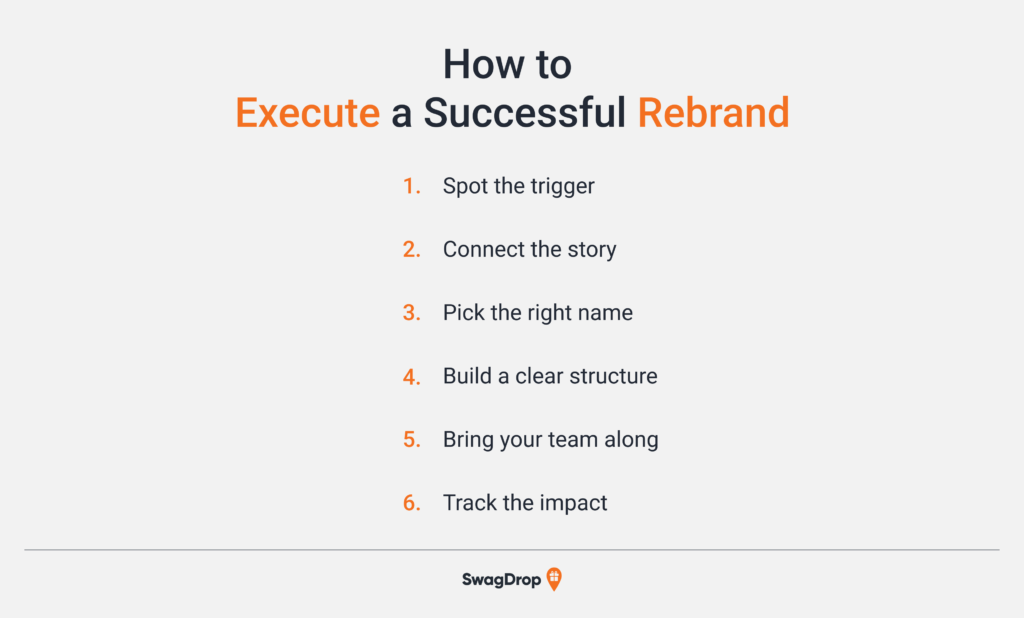Grammarly recently rebranded to Superhuman, bringing Grammarly, Coda, Superhuman Mail, and Superhuman Go together in one AI-powered productivity suite.
The familiar Grammarly product still lives within the platform, serving as a key part of a broader vision for smarter writing, communication, and collaboration.
This bold strategic move to consolidate products, talent, and technology into a unified system competes directly with top AI productivity tools like Microsoft Copilot and Google Duet.
Our SwagDrop team found this story fascinating because it captures the exact challenges our clients experience during large-scale rebrands.
We wrote this case study to help businesses learn from this transformation and apply its lessons to their own rebranding journeys.

Table of Contents
Why Change a Legacy Brand Name?
The Strategic Role of Mergers and Acquisitions (M&A)
How to Execute a Rebrand Like This
How to Turn a Rebrand Strategy into Adoption
Key Rebrand Lessons
Here is a quick look at the main lessons you’ll learn from this case study, as we break down Grammarly’s shift to Superhuman:
- Keep something familiar. Rebrands work better when your audience can spot a product or service they already trust inside the new system.
- Choose a name that aligns with your direction. A future-focused name gives your brand room to grow and helps people understand the bigger vision behind your expansion.
- Let acquisitions work together. Connect all products or services in your portfolio under one clear brand story.
- Follow a clear plan. A step-by-step approach keeps your teams aligned and makes the process smoother and more organized.
- Turn the brand into an experience. Help employees and customers adopt the new identity more quickly with branded giveaways they’ll use daily.
What Changed vs. What Stayed
Key lesson: Rebrands gain momentum when people recognize the product they already trust inside the new structure. Include something familiar inside the fresh system to help everyone understand and accept the change.
Grammarly’s rebrand to Superhuman created a lot of buzz, and for good reason. This move redefined the company’s purpose and products, while staying true to the values that made it one of the most trusted names in digital communication.
A bold new name
The company name is now Superhuman, but the Grammarly product still plays a central role.
This rebrand simply shows that the company now represents something larger than a single tool.
Superhuman is the new umbrella term for an extensive family of AI-powered products designed to increase productivity in every corner of modern work.
Four tools in one platform
The new Superhuman Suite connects four key products:
- Grammarly remains the go-to writing assistant that helps teams express themselves across emails, chats, and documents. This solution identifies grammatical errors and enhances phrasing, tone, and readability.
- Coda is the suite’s collaborative workspace, where docs, spreadsheets, and apps come together to improve collaboration, planning, and workflow automation. It enables you to track projects, automate tasks, and keep everyone working in sync without needing to switch between tools.
- Superhuman Mail is the productivity-focused email platform that started this new identity. This tool helps employees manage their inboxes faster through AI-powered drafts, conversation summaries, and contextual follow-up reminders.
- Superhuman Go is the newest addition to the suite. This smart AI agent connects across all Superhuman tools to assist teams with drafting content, retrieving information, and automating routine tasks.
These products form a connected system that redefines how people work by combining writing, collaboration, communication, and AI insights into a single experience.
Same mission, expanded vision
While the name changed, the mission remains the same: to empower people to communicate and perform their best through technology.
What has changed is the scale of that mission. Superhuman now focuses on optimizing how people write, plan, and collaborate across entire workflows, instead of improving only one part of it.
Still, why change a name loved by millions? The answer lies in how fast brands can outgrow the stories they started with.
Why Change a Legacy Brand Name?
Key lesson: A brand name is most effective when it accurately reflects the company’s value proposition. A broader identity gives your business room to grow and explore new products or services.
Legacy brands can reach a point where growth starts to stretch their original identity.
Grammarly’s move to Superhuman shows how outgrowing a familiar name can open new doors for innovation and expansion.
The name boxes you in
The name Grammarly was perfectly suited for a company known for improving writing skills.
Yet, as the company’s tools expanded into email, collaboration, and AI-driven productivity, the name began to feel too narrow.
Most users still associate the name with grammar correction, rather than a comprehensive platform that connects work across documents, projects, and communication channels.
Thus, Grammarly needed a new name that represented what it had become rather than what it started as.
AI changes the playing field
AI has transformed the way people create and manage information.
Platforms like Microsoft Copilot and Google Duet changed user expectations by offering intelligent assistance for every task.
Grammarly picked up on this trend early on and evolved from a single-use assistant into a suite of connected products that offer proactive AI support.
The Superhuman identity draws attention to that evolution and positions the company among today’s leading AI productivity systems.
Public reactions
Every major rebrand generates mixed public emotions, and the same goes for Superhuman.
On the positive side, LinkedIn members share that:
“Grammarly just did something NO established brand ever dares to do. They killed their own name and became Superhuman. This isn’t just a rebrand. It’s a masterclass in leadership from Shishir Mehrotra.” — Justine C.
“Grammarly rebranding to Superhuman is packed with lessons in business, product, and positioning strategy. […] Whether Grammarly had to do this or not matters less. What matters is that they had the guts to make the move. […] Well played, Shishir, and the Grammarly team.” — George Chasiotis
Other reviewers are more critical:
“In 6 months time when everyone has an AI assistant, brand trust will be the only thing that convinces users to give them access to everything. Grammarly just traded recognition for aspiration. I’m calling it: in a commodity market, that’s usually how you lose.” — Bryan Karas
“Grammarly kills its perfectly good name to become ‘Superhuman’—because nothing says originality like sounding exactly like every other AI startup.” — Jennifer Young
These reactions prove that even with a smart rebranding strategy, you still need to overcome emotional and subconscious consumer biases.
The Strategic Role of Mergers and Acquisitions (M&A)
Key lesson: Acquisitions create powerful opportunities when they support one clear brand story. A unified name connects all your products or services, helping customers understand how the pieces fit together.
Major rebrands don’t happen overnight. Companies typically take months or even years to determine their desired direction.
Grammarly’s transformation into Superhuman began with two smart acquisitions that helped expand its vision beyond writing assistance.
Check out their strategic moves:
- In December 2024, Grammarly announced its acquisition of Coda, a collaborative workspace platform. This deal also brought in Coda’s co-founder and CEO, Shishir Mehrotra, who became the new head of the combined company.
- In June 2025, Grammarly shared the news that it’s buying Superhuman Mail, the popular AI email app.
- On October 29, 2025, Grammarly officially rebranded to Superhuman, launching the Superhuman Suite and introducing its new AI assistant, Superhuman Go.
Each move built on the last. Coda added collaboration and automation, while Superhuman Mail brought speed and communication expertise.
Should you rebrand everything?
Grammarly’s choice to go all-in on the Superhuman name simplified its story. A unified masterbrand builds recognition faster, simplifies marketing, and helps the audience understand how the products connect.
The downside of this move is that it can cause short-term confusion as people adjust to the change. You also need to work hard to explain the new identity to loyal customers and maintain their trust.
Your other option is the house-of-brands strategy, where each product keeps its own name and personality. This approach protects existing brand loyalty and offers more audience and market flexibility.
The trade-off is complexity. Managing separate brands is time-consuming and requires more money and coordination. This model can dilute each brand’s message and make it harder for your teams to maintain a unified story.
Now, let’s see how you can plan and execute a successful rebrand.
How to Execute a Rebrand Like This
Key lesson: A successful rebrand needs structure, clarity, and teamwork. A simple step-by-step plan keeps everyone focused and creates a smoother transition for your employees and customers.
A rebrand succeeds only when every employee, customer, and partner understands the change and feels part of it.
Here’s a step-by-step guide to building a winning strategy:

1. Spot the trigger
Identify the moment when your brand needs to evolve. You could have expanded your product line, or your market shifted.
Grammarly reached that point when its writing identity no longer matched its expanding AI platform.
Define your reason early so every decision supports your goal.
2. Connect the story
If your rebrand follows an acquisition or the launch of new products, tie everything together with a single, clear message.
Grammarly merged Coda and Superhuman Mail into its story of smarter, faster work.
If you connect all the pieces under one purpose, you help customers and teams see growth instead of disruption.
3. Pick the right name
Choose a name that aligns with your vision and is easy to remember.
Grammarly retained its well-known product name but changed the company name to Superhuman to demonstrate its scale and ambition.
Test the name with your employees, partners, and even a small group of customers to make sure it feels right and sounds natural.
4. Build a clear structure
If you offer multiple products, determine how they align under your new brand.
Grammarly packaged its tools into the Superhuman Suite to create a connected experience.
Use consistent design, naming, and navigation to make your new brand easy to follow and trust.
5. Bring your team along
Prepare your people before the launch, so they know how to tell the story.
Share brand kits, talking points, and ready-to-use templates, and create space for feedback and questions.
Celebrate small wins with employee rewards to maintain high morale and engagement throughout the rollout.
6. Track the impact
After the launch, track how your new brand performs.
Examine key metrics, including brand awareness, sentiment, and customer engagement.
Keep an eye on what’s working and refine what isn’t to meet your end goals.
Next, learn how we can help you persuade clients and employees to adopt your new brand fully.
How to Turn a Rebrand Strategy into Adoption
Key lesson: People embrace a new brand when they can interact with it in real life. Thoughtful branded swag makes your company’s new identity feel natural and exciting from the start.
Rebrand announcements on social media, press coverage, and website updates only go so far. People also need to feel the new brand in their hands, on their desks, and in their lives to fully embrace it.
Branded merchandise serves as a daily reminder of your company’s new direction, helping employees and customers feel part of the change.
Still, most companies struggle with the complex logistics of managing old swag inventory while trying to source and distribute new products. The process is time-consuming, involves numerous vendors, and can result in waste or inconsistent branding.
At SwagDrop, we leverage our 30+ years of experience in branded swag to help you streamline the process and turn your new brand identity into everyday experiences that generate excitement and pride.
Here’s what happens step-by-step when you reach out to us.
Step 1: Share your brand assets and goals
Our collaboration starts with a short kickoff call.
You tell us a little bit about your audience, timelines, and what you want people to feel when they receive the new brand.
This call helps us understand the tone and direction of your rebrand before suggesting any products.
Then, you send us your logo files, colors, fonts, and any specific messaging you want included.
Step 2: Review a curated selection of on-brand swag
We examine your colors, audience, and the message you want your rebrand to convey, and handpick high-quality promotional products that reflect that direction.
You receive a tailored list of options and decide what to keep, add, or discard.
We refine the collection based on your feedback until every company swag item matches the new brand experience you want people to have.
Step 3: Approve your fully branded online store
Once you approve the product list, we build your swag-on-demand company store.
We apply your updated identity to the storefront’s banner, ribbon, and product mockups to create a cohesive look that is true to your rebrand.

You can share the shop preview with your internal teams and let us know if you’d like to make any changes.
After we receive your approval, we double-check every logo placement, color match, and print file to ensure everything’s ready for the launch.
Step 4: Let your people choose their own swag
Your branded gift store goes live within one week of our initial call.
Employees or customers visit the shop through a secure link, browse the curated collection, and choose promotional gifts that fit their style or needs.

This choice helps people connect with your new brand identity and proudly show it off from day one.
We print and ship items only when someone places an order, ensuring a fast, clean, and waste-free process.
Step 5: Track how your new identity takes hold
Once your swag store goes live, we give you full visibility into how your rollout performs.
Our detailed redemption reports show you who redeemed gifts, which products people loved most, and how fast recipients embraced the new look.
These insights help you measure real adoption and make smarter decisions for your next campaigns.
Step 6: Keep your brand present all year
A rebrand sparks excitement and opens the door to ongoing brand engagement.
You can continue growing your swag program with multiple shops, including:
- Short-term campaign stores for your brand launch events
- Ongoing gift shops for employee and client onboarding and recognition
- Permanent e-commerce stores for year-round visibility

Each store improves your brand presence and keeps people excited long after launch day.
Real customer feedback
If you’re on the fence whether we can handle your rebrand, just take a look at how Angelica Colantuoni, who manages swag for a 3,500-employee company, describes her experience with SwagDrop:
“Our company just went through a huge transition with four new brands, six different logos, and countless last-minute orders, and SwagDrop has been there for us every single step of the way.
Their team is unbelievably organized, creative, and reliable. No matter how complex our requests are, they make it easy. They always bring amazing options, keep everything on track, and somehow make the process fun. They take what could be a stressful situation and turn it into something exciting.”
Tips, tricks, and inspiration delivered straight to your inbox.
Making Bold Brand Shifts Work
Grammarly’s transformation into Superhuman shows that bold moves can expand a brand’s reach without losing its roots.
The company turned complexity into clarity by uniting its products under a single vision, a lesson every growing business can apply.
The key is to stay flexible, measure impact, and keep your story alive.
Branded merch also plays an essential role in any rebranding journey, by turning a new identity into something people can see, wear, and celebrate every day.
Book a call with us today if you’re ready to bring your new brand to life.
Frequently Asked Questions (FAQs)
For more info, check out these answers:
Did Superhuman buy Grammarly?
No, Superhuman didn’t buy Grammarly. The parent company, formerly known as Grammarly, changed its name to Superhuman after acquiring Superhuman Mail and Coda. The Grammarly writing product is now part of a broader AI-powered productivity platform.
Is Grammarly a Ukrainian company?
While Grammarly was founded in Ukraine, the company now operates globally under the name Superhuman. Yet, the business has been actively supporting its native country ever since the beginning of the war in 2022. Grammarly has made donations to Ukrainian aid efforts, offered free access to Ukrainian nonprofits and media organizations, and blocked users in Russia and Belarus from using its products. Access the company’s Stand With Ukraine page for more details.
What is Superhuman Go?
Superhuman Go is an AI assistant that integrates with over 100 apps to help users stay focused and productive. This tool anticipates your needs, generates relevant context, drafts content, and suggests next steps, eliminating the need for manual searches or switching between tools.
Who bought Superhuman?
Grammarly announced its acquisition of Superhuman Mail in June 2025. A few months after the acquisition, Grammarly changed its brand name to “Superhuman”.
Which is better, ChatGPT or Grammarly?
These AI tools serve different needs. ChatGPT excels at brainstorming and generating creative text. The Grammarly writing tool, now part of the Superhuman Suite, focuses on improving writing with feedback on grammar, tone, and clarity, while also integrating with tools like Coda and Superhuman Mail to increase productivity. Choose the tool that best suits your creativity or precision needs.


